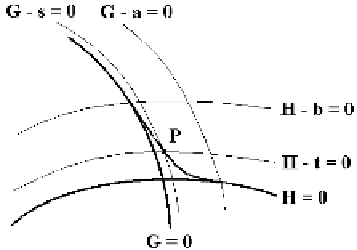Graphics Reference
In-Depth Information
Figure 15.18.
Blending with intersections of
offsets.
T
able 15.6.1
Type of conic
l=-•
A pair of lines: s
=
0 and t
=
0
-•<l<-
ab
Hyperbola
l=-
ab
Parabola
-
ab
<l<
ab
Ellipse: a circle if a
=
b and
l=
0
l=
ab
The line bs
+
at
-
ab
=
0, counted double
reduced the blending problem for surfaces to the problem of finding a blending func-
tion f(s,t) for the coordinate axes in parameter space that is much easier. Further-
more, if the functions we are dealing with are polynomials, then we would like f to
have as low a degree as possible. The natural candidate for f is therefore a conic. In
view of the tangency conditions, the general form for f is
()
=
22
22
2 2
2
2
fst
,
bs
+
a t
+
a b
-
2
abs
-
2
a bt
+
2l
st
,
(15.17)
where a, b, and l are parameters we are free to choose. The parameters a and b specify
the points of tangency and l determines the type of conic we are using (see Table
15.6.1). With this choice of f, the blending surface F will have degree 2(m + n) if G
and H have degree m and n, respectively. If G and H are quadratics, then F will be a
quartic.
15.6.2
Example.
Consider the cylinder V(G) and plane V(H), where
(
)
=+-
2
2
(
)
=-
Gxyz
,,
x
y
25
and
Hxyz
,,
y
2
.
We would like a blending surface that meets V(G) and V(H) in the vertical lines
through (4,3) and (6,2), respectively.
Solution.
See Figure 15.19(a). If we set a = 11, b = 1, and l=-11 in equation (15.17),
then
()
=+
2
2
fst
,
s
121
t
+ - -
121
22
s
242
t
-
22
st
.






